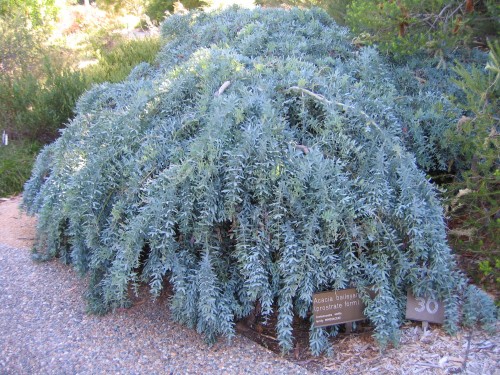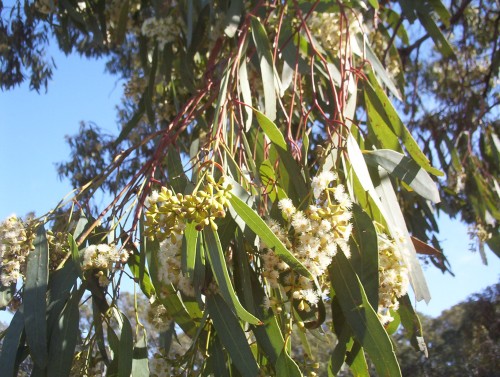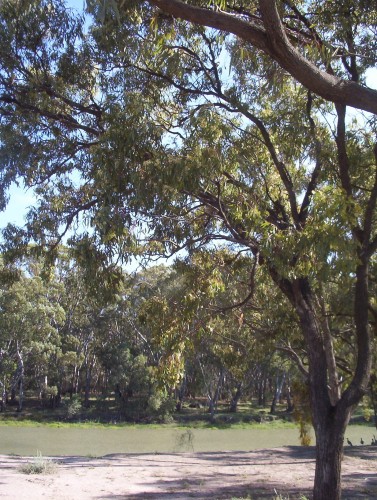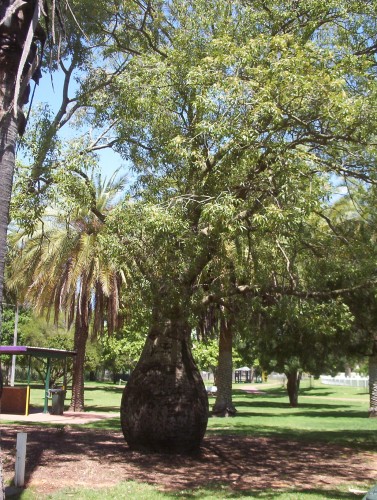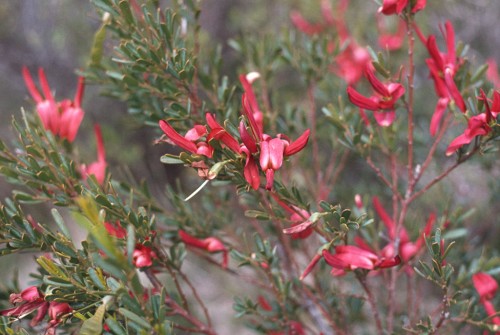Acacia baileyana prostrate form (Cootamundra Wattle)
The prostrate form of Acacia baileyana is a lovely form of the taller tree. Even without flowers, the dense, grey green foliage is attractive in a garden setting. It cascades over slopes and follows the contour of the ground and it is excellent for covering large areas as a ground cover as it grows 30-60 cm tall and 3-4 metres wide. It has bright yellow flowers from winter to spring. It is a very hardy plant in most situations, withstanding dry periods and growing in full sun to part shade in sand, clay or loam.
A photo of the larger form in flower can be seen here.
Chrysocephalum semipapposum (Clustered Everlasting)
This is one of my favourite plants and it is a member of the daisy family. Members of The Daisy Study Group had several forms of Chrysocephalum semipapposum growing. Chrysocephalum used to be Helichrysm.
It is a variable species with grey to green leaves which vary in width from quite fine to a coarser leaved form. It has clusters of small yellow flowers, which, if picked quite early in the flowering stage, will keep as an everlasting. If picked to late the flower will continue to open and the seeds will fluff out.
The plants grow from 50-80cm tall and make clumps up to a metre wide. Flowering is from Spring through to autumn so they are good value in the garden, especially in a cottage garden setting. The plants shoot from the bottom, so when the first signs of shooting appear, it is time to chop the clumps back to the new growth.
This plant is hardy in most situations and grows in full sun to filtered or part sun. It withstands periods of dryness but does best with extra moisture. The plant is suitable for heavy clay, loams and sand.
Eucalyptus largiflorens(Black Box)
This is an attractive small to medium tree, 10-20 metres high by 8-15 metres wide, with large clusters of cream flowers loved by bees and Honeyeaters. Black Box are known as good honey producing trees. These trees are seen on the banks or rivers and lakes in Queensland, New South Wales, Victoria and South Australia, usually in low lying areas where water once lay. This stimulates the seed germination and is why stands of these trees are often seen in the middle of nowhere. If lakes or rivers have flooded, these seed capsules are left washed at the highest point at that time which may never be reached again. The soils in these areas are clays to heavy loams, which of course makes them ideal for such soils in home gardens, where the soils are poorly drained or alkaline. These trees are also resistant to heavy frost. Flowering is between August and January.
I can’t believe that the proposed name change for this tree is ‘Symphymomyrtus’ ie. the plant is possibly called Symphymomyrtus largiflorens! I haven’t kept up with all the Eucalyptus name changes, except for Corymbia ficifolia (Eucalyptus ficifolia, Western Australian Flowering Gum).
This photo was taken on the banks of the Murrumbidgee at Hay, in NSW.
Brachychiton rupestris (Bottle Tree)
I found this unusual tree in a park in Nerrandera. It grows to a height of 10-20 metres and a width of 5-15m. It has yellow belll flowers in clusters, each flower about 5 cm long, in Spring and Summer. It grows in full or part sun, in acidic to mildly alkaline sand loam or clay, and tolerates some dryness. It is suitable hills areas and inland planting. The foliage can be partly deciduous, and stock will eat it.
This plant is suitable for pots, parks and large gardens in favourable areas. As it is so slow growing, it would take many years to be a large tree. More information can be found here.
This plant has been used by Aboriginal people as bush tucker. Warning: the seed pods of Brachychiton rupestris (Bottle Tree) have irritating hairs.
Foliage, roots and seeds are edible, however seeds must be roasted. Another warning! Be sure of the identity of all bush tucker plants before eating!
Templetonia retusa (Cocky’s Tongue)
There are large, red pea shaped flowers very attractive to birds and butterflies, during winter and spring. This is a hardy plant suitable for front line coast and inland situations. It is moderately frost tolerant and requires good drainage. This can be achieved by creating a planting mound at least 5-10cm higher than the surrounding soil, if drainage is a problem. Templetonia retusa is found in South Australia and Western Australia. More information can be found here and here.
